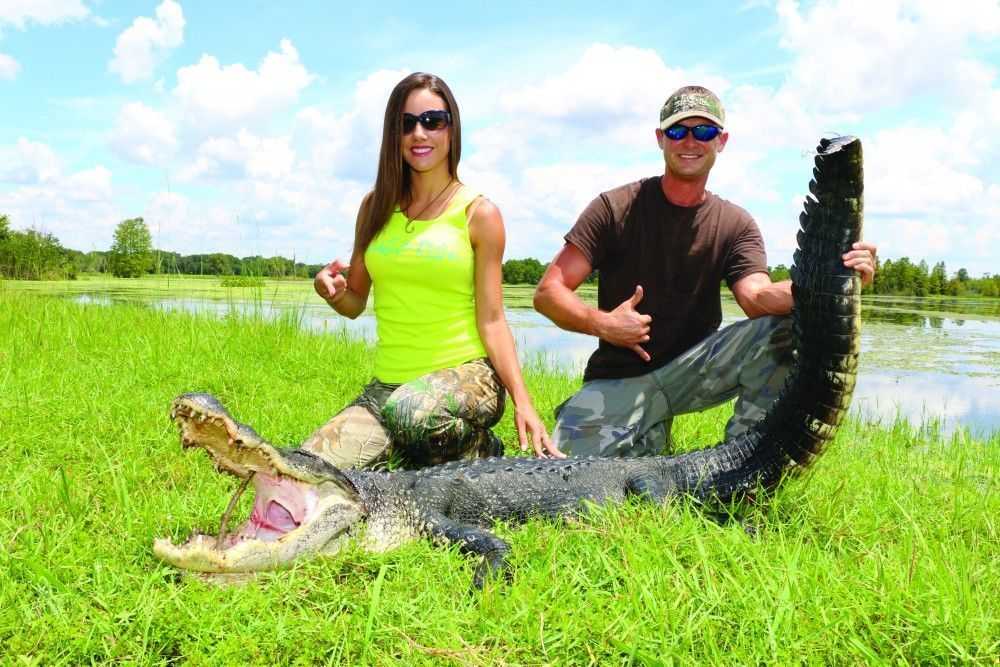Photos by Capt. Jimmy Nelson
Go Get Your Florida Gator
By Garrett Norris
Before retiring the tarpon rod for the bow next year, try hooking into a gator. Florida’s alligator season starts in the middle of August and ends Nov. 1. Permit applications are due in April and are picked by a random drawing. If you’re lucky enough to be chosen, the permit fee is $272 for Florida residents and $1,022 for non-residents. Everyone who participates in an alligator hunt must purchase an agent’s license, which is available at the cost of $51.50.
Once you get your permit and your paperwork, there is a lot to learn before you hit the water. Gator hunting is as safe as you make it.
The tackle varies depending on how you want to take a gator. The most common method is to throw a treble hook from large spinning rod to snag the gator. The spool should be filled with 60- to 100-pound braided line, and a 12/0 3x Mustad treble hook is a good one, especially once a bench grinder is used to remove the barbs and grind the points as sharp as possible. This should be rigged with a light lead (weight varies from spot to spot) and a foot or more of small braided rope as a leader.
A harpoon is the next tool to have in your arsenal. Once near enough to the treble-hooked alligator, the harpoon is used to drive a dart with a line and buoy into the gator. This allows the hunter to turn and control the animal. Bigger gators may require more darts and lines to wear them down. The best placement of a harpoon dart is in the neck or ribs, although a leg or a tail shot works in a rush. A bowfishing bow with a line and buoy attached can be used in the same manner.
It’s difficult to look at the red glowing eyes and know how big a gator is. Sometimes actions will give it away. Big stubborn gators on public water won’t let you put a light on them long; they tend to quietly slip away. Some will just sink to the bottom and wait for you to go by. Large cleared trails through aquatic weeds and brush are a sure sign a gator is using the area. Many times a gator will have many babies around. This is usually a female protecting her young from other larger predators, mainly male gators. When encountering a 5 to 8 foot gator in heavy cover, this is usually a female and should be passed, as she is our future breeding stock.
In hunting a big gator, there can be many nights of scouting and casting with no success. Once we find a gator worth filling a tag, we slowly creep within casting range and throw the treble hook until we get a hook set. With the first line in, it’s a matter of playing the gator and maneuvering the boat to get harpoon or bow lines in. Once the animal is wrestled to the side of the boat, we use a bang stick to finish it. A bang stick is a pole with a firearm cartridge at the end. It fires when pressed hard behind the gator’s head. To sever the spine, you want to hit the gator an inch or two behind the half moon shape on top of its head. It helps to coat the rim of the shell and the primer with fingernail polish, which makes it more water resistant.
You can forget just about everything you may have seen on TV about gator hunting. Different states have different laws, and in Florida no shots from firearms or baited hooks are allowed. A baited wooden peg no longer than 2 inches is allowed, but it must be tied to a handling line kept in the boat at all times.
Legal hunting hours are 5 p.m. to 10 a.m., so most hunting is done at night. The single most important item is a good spotlight. We use a 100w halogen light on a headband that’s attached to a car battery. Ultra-light is the brand headlight we use.
After a gator is taken, you have the option of keeping it or selling it to a licensed processor, who will pay you by the foot. A processor can also clean the gator for you for a fee. If the gator is going to sit a while before it is cleaned, place it on a tarp, pour ice all around it and wrap the tarp over. If the skin starts to peel, the gator is spoiling and the processor will reject it.
If you decide to keep it and clean it yourself, it’s best to lay the gator out on a hard clean surface and scrub it down with bleach and dish soap so no bacteria gets on the meat when you skin the animal. Most people prefer a gator in the 6- to 7-foot range for the best tasting meat. The tail provides the most meat, but don’t forget to clean the legs and the meat off the jaws.
People new to gator hunting should consider hiring a local guide to help fill their tags, and some guides have tags clients can help fill. There is a list of alligator guides on the FWC website at http://myfwc.com/wildlifehabitats/managed/alligator/links/. Guides like Tanner Norris, from Osceola Connections in central Florida, or Cary Crutchfield, with Florida Cracker Alligator Inc., in north-central Florida, are your best bet to fill tags. They will provide the safest hunt full of unforgettable moments and pictures to show and brag to all your friends.
